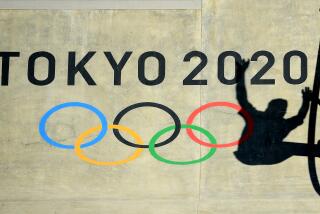Japanese Believe in Big Bang Theory of Summer Fun
- Share via
YOKOSUKA, Japan — The pleasures of August, for many Americans, include lemonade, lying in the afternoon shade, and the smells of cut grass and barbecues. But in Japan, the biggest delight of the season for millions is the sound of fireworks popping.
On summer evenings, people don crisp cotton yukata, or robes, and head for rivers or the seashore to see the fabled displays. For centuries, this country has been crazy about fireworks. Each year, Japan stages up to 7,000 public fireworks extravaganzas, mostly in July and August. The 300 largest festivals are renowned for the beauty of their fireworks, their huge and happy crowds, and their fabulous cost, which can exceed $1.8 million.
Japan boasts of making the world’s highest-quality pyrotechnics: perfect spheres that fill the sky, unfolding chrysanthemums, sparkling tulips, fairies, phoenixes, cartoon characters, even a celestial Mt. Fuji. All told, the country spends $134.5 million a year on fireworks, according to the Japan Pyrotechnics Assn. That works out to more than $1 of fireworks per capita for Japan’s 126 million inhabitants.
Ardent fireworks fans travel the archipelago in search of the most charming summer festivals and the best fireworks displays. The cyber-literate are now aided by fireworks schedules posted on the Internet. They can also view photos of the latest pyro-wizardry, including the winners of the prestigious annual fireworks competition that will be held Saturday in Akita prefecture.
This summer, despite Japan’s economic woes, nobody is skimping on the glitz and glory. The famous annual fireworks show along Tokyo’s Sumida River drew 900,000 people and cost $1.4 million--at a time when the Tokyo government is teetering on the edge of bankruptcy. Because the river is narrow in parts and winds through old neighborhoods of wooden houses, huge fireworks displays are banned. But what the display loses in size, it makes up for in quantity: 20,000 fireworks were lighted from two locations in an exhibition that lasted 80 minutes.
Public funding for the Sumida River fireworks was scaled back by 6% this year because of the fiscal crisis, said Tomotaka Kawano of the Cultural Events Division of the Sumida ward office, and private contributions from corporations were no greater than usual. So how did the cash-strapped city make up the difference? “We asked the fireworks makers for a discount,” Kawano said.
Officials in Tokyo and organizers of other provincial shows agreed that despite the continuing budget squeeze, fireworks must be spared.
“They may reduce the number of public toilets, but they will never cut back on the fireworks,” said Maki Saito, a tourism official in Nagaoka, a city of 191,000 in central Japan that drew 650,000 spectators for its famous two-day festival.
Fireworks have been prized in Japan since at least 1589, when samurai lord Masamune Date enjoyed an exhibition of Chinese-made rockets. The aristocracy’s penchant for pyrotechnics was the cause of so many fires that the ruling Tokugawa shogunate banned fireworks at least six times. Finally, the shoguns relented and in 1733 commanded a fireworks display to purify the land after a plague and famine.
The Japanese word for fireworks is hanabi--literally “flower fire.” Their fleeting beauty is often compared to that of the ephemeral cherry blossom.
“Hanabi vanish into smoke and air, so Japanese want to see them again and again,” said Kichiji Wada, the third-generation president of Fire Art Co., one of 186 mostly family-run fireworks manufacturers. “If they stuck around, people might get sick of them.”
“It’s like putting a person’s whole life up into the sky for an instant,” said Haruyuki Kono, general secretary of the prestigious Japan Fireworks Artists Assn. “Bang, it’s up; bang, it’s gone.”
Though some young Japanese shun as too hokey traditional folk dancing at summer festivals to honor the ancestors, fireworks have not lost their appeal. At a recent display at a Japanese Self Defense Forces training base in Yokosuka, 39 miles south of Tokyo, toddlers in traditional Japanese summer clothing munched corn on the cob and balls of grilled octopus, while young women in brightly colored yukata and bleached-blond hair gabbed on tiny mobile phones waiting for the show to start.
More to Read
Sign up for The Wild
We’ll help you find the best places to hike, bike and run, as well as the perfect silent spots for meditation and yoga.
You may occasionally receive promotional content from the Los Angeles Times.





